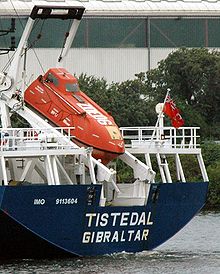Freefall lifeboat
A free-fall lifeboat is a special form of lifeboat on board ships . They are subject to the regulations of the International Maritime Organization .
history
The first patent for a free fall boat was granted to the Swede AE Falk in 1897. It was a closed boat that could slide from about three meters from the stern of a ship. In 1939, a Captain White of the Bay and River Navigation Company submitted a concept for a free-fall boat (he described it as an unsinkable submarine lifeboat ) to the Bureau of Marine Inspection and Navigation of the US Department of Commerce was classified as inadequate and dangerous due to the expected speed when hitting the water surface . The first practical implementation was initiated in 1959 when a Dutch captain approached Joost Verhoef, whose shipyard Verhoef Aluminum Scheepsbouw in Aalsmeer took over the planning and construction. Made of aluminum, the freefall boat resembled a small submarine and was installed on a seagoing ship in 1961. There was no further development or production until the early 1970s, when the Norwegian companies Harding initially researched a free-fall boat and Nor Davit, Mjöllner Industrier, independently of one another, on a dropping system. In 1973, the Norwegian safety authority Norwegian Maritime Directorate entrusted the Norges Skipstekniske Forskningsinstitutt (MARINTEK) with the management of research by the various companies. In 1976, the first practical tests were carried out in the Hardangerfjord, in June 1977 the first test drop with crew from the ship Tarcoola followed on the Öresundvarvet in Landskrona, and after further test drops, it was approved as a life-saving appliance in September 1978. In Germany, research into the free-fall lifeboat was part of the Ship of the Future research project carried out in the early 1980s . The first ships in Germany to be equipped with a free-fall lifeboat were the reefer vessels Blumenthal and Bremerhaven of the Flensburg shipping company Ernst Jacob , which were put into service in late 1983 and early 1984 .
functionality
Free-fall lifeboats are typically closed lifeboats attached to the stern of a ship , which in an emergency can slide and fall from an inclined launching device into the water without external assistance. You can be reached quickly from the team quarters.
Freefall lifeboats are completely closed as they are submerged for a short time when they hit the water. A door at the rear serves as entry. The crew members sit opposite to the direction of travel. Since the boats hit the water from a great height and with great force, all occupants have to buckle up and also press their heads against the backrest to avoid injuries. Often the seats are fixed among the crew members; this should enable faster boarding.
The release mechanism is located inside and is operated by the operator of the boat. A hydraulic bolt is actuated with a lever , which releases the originally locked free-fall boat so that it starts moving, driven by its weight. Then the boat can be maneuvered out of the dangerous situation with its own engine. It is equipped with the items required by the international ship safety treaty for movement, for making noticeable as well as for the protection and survival of the occupants. There are also free-fall lifeboats on tankers, which are equipped with a mechanism that creates a fine spray around the boat so as not to catch fire in the event of an oil fire on the water.
The runway has an angle of about 40 ° to the horizontal, has support and guide rollers and converts part of the initial height of the boat into horizontal relative speed compared to the ship. This ensures that in the event of a fall and afterwards the boat moves away from the ship and from the dangers threatening it (fire, capsize suction, air bubbles). The boat can be guided by these rollers on the underside and the side surfaces of the hull or on suitably designed side rubbing strips. So that the boat does not receive a significant torque impulse around its transverse axis (tilting acceleration forward) on the way after moving its center of gravity beyond the outermost support points, the support surface on the underside of the boat can be bent upwards at an angle of 5–10 ° from the center of the boat, so that there is free space is created for the translational movement on a trajectory parabola that is curved downwards. If this overturning moment is avoided, the boat hits the imaginary water surface in a smaller angular range regardless of the ship's variable loading depth. The aim is to slide the boat into the water at a certain angle in order to keep the braking acceleration acting on the occupants as low as possible.
See also
- Escape capsule section of offshore structures
Individual evidence
- ↑ James K. Nelson, Tycho K. Fredericks, Steven E. Butt, Scott N. MacKinnon: Evaluation of Occupant Seats and Seating Space in Free-Fall Lifeboats , International Maritime Organization - Subcommittee on Ship Design and Equipment , November 19, 2004, Pp. 5-7.
- ^ The Norwegian Free Fall Survival System . In: Hansa - Schiffahrt - Schiffbau - Hafen , Vol. 118, No. 17, September 1981, pp. 1235 f.
- ↑ With a "thump" to safety . In: Schiffahrt international , issue 2/1984, Koehlers Verlagsgesellschaft, Herford, p. 53 f.
- ^ MS Helene Jacob . In: Schiffahrt international , issue 2/1984, Koehlers Verlagsgesellschaft, Herford, p. 52 f.


